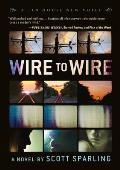
Is it dangerous?
That's the question people ask when they find out I spent a large part of my youth hopping freight trains and traveling in boxcars across the Midwest, through the western U.S., and across Canada.
The answer, for the record, is yes. Dangerous and illegal. You shouldn't do it. You should also abstain from the other bad behavior described in Wire to Wire. Throwing knives. Sniffing glue. Selling drugs. Falling in love. All can be fatal.
Now that we've got that out of the way, the real answer is that it rarely felt dangerous. Mainly because we were good at it — we being Jesse and me. We had rules, and unlike the characters of Wire to Wire, we followed them. We took no chances.
I had another advantage. It was Jesse who knew freights, who intuitively understood their world. He was better at it, mostly, but I had the edge in balance and I could climb anything. (Hence my road name, Spider Rider. What can I say — it looked good on the side of a boxcar.) So if a hop seemed safe to Jesse — and we were always conservative risk-assessors — it was extra safe for me.
A little bragging: In Minneapolis, I jumped from the Humboldt St. overpass onto a moving Milwaukee Road freight and rode it across the Mississippi River. I got a sunburn that day, which, in retrospect, was probably more dangerous than the hop. (Don't try that jump today — the trains are gone. It's a bike trail now. You'd kill yourself.)
Somewhere in Canada, with two freights running side-by-side, I jumped from one moving train to another. Not because I liked taking chances. Because I was sure it was safe.
The truth is, I was ill suited for freight-riding in several ways, but the athletic part I could handle.
So I was baffled, briefly, when we filmed the video trailer for Wire to Wire. A crew of very smart, very creative folks from the film company Juliet Zulu were in charge, working with my editor from Tin House, Tony Perez. Late in the day, after a little trespassing in the name of literary fiction, we found ourselves looking down a railroad track at an oncoming freight. Zak Davis, the director, explained the shot to me. Tony would hop the freight, and I would wave at him as he passed by.
"Wait," I said. "Why don't you want me to hop the freight, too?"
There was a pause while everyone passed a look around. A look that said, we're trying to promote this guy's book, not get him killed. Then, very tactfully, Zak said, "Well, we didn't want to presume, but... if you think you can... "
For the record, we did seven takes on the freight-hopping scene, every one a winner. Sure, the years have flown, it's not the '70s anymore. I'm aware of all that. But yeah — I still got it.
There was only one casualty. More of a scrape, really. Somehow in all the excitement, a copy of Wire to Wire — my copy, the first one, the book I'd spent 20 years writing — got left on the track. The train hit it and sent it 10 feet in the air.
I found it in the dirt, scraped up by steel wheels. Damaged by violence, twisted for sure, and a little bit blessed. Which is what I was trying to write about all along.
÷ ÷ ÷